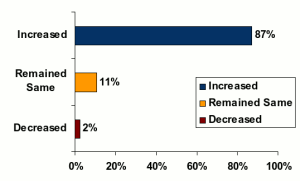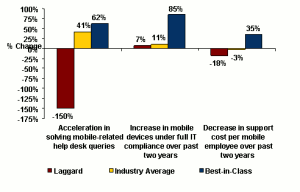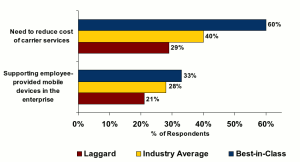
As the handheld mobile device has evolved from pager to cell phone to smartphone to mobile computing asset, enterprise mobility has become increasingly vital to conducting tactical, operational, and strategic business transactions.
On top of this, the growth in enterprise mobile adoption, combined with increased device complexity, demands greater IT management and support. These additional resources are required to adequately support the mobile device, platform, and applications that are increasingly being used by employees to supplement or replace their laptops or personal computers.
“The enterprise has found it crucial to adopt mobility into basic operations and communications wherever feasible,” said Andrew Borg, senior research analyst for Wireless and Mobility at Aberdeen Group.
Even in the last year, businesses have increasingly adopted smartphones into the mobility lexicon (Figure 1).
Those companies that achieved Best-in-Class performance (the top 20 percent of the aggregate of survey respondents) have led the charge, increasing their number of smartphones by 72 percent.
Mobility in general, for the top performers, can increase employee productivity by 40 percent, customer satisfaction by 35 percent, and can even increase employee retention by 25 percent.
“Given the demand for more and advanced mobility in the enterprise, companies face significant challenges pursuing the appropriate level of mobile support,” said Borg. Defining the appropriate level will address the organizational breadth of end users, the technical challenges associated with increasingly complex devices and applications, and the fragmented landscape of solution providers that delivers a wide array of skill sets, he said.
Outsourcing Mobility Management
Best-in-Class organizations outsource a number of device management and support capabilities to a far greater extent than their Industry Average and Laggard counterparts, “allowing them to focus internal resources on their core competencies while providing more efficient mobile support in a number of areas,” said Hyoun Park, research editor for telecom lifecycle management at Aberdeen Group.
Mobility device support options include in-house solutions, systems integrators, managed mobile service providers, mobile device management vendors, mobile software providers, and wireless carriers.
The six solutions, coauthors Borg and Park agree, offer a wide array of options for managing mobility support initiatives.
“When choosing an outsourced solution, it is vital to first identify the critical success factors for implementation and ongoing support,” said Park. “It is then important to enable proper alignment between the business need and the services of the mobile outsourcing provider.”
To distinguish the Best-in-Class from Industry Average and Laggard organizations, Borg and Park used three key performance indicators (KPIs), which represent operational metrics that affect employee productivity, compliance with corporate IT standards, and the ability to drive down the mobility cost per employee. These KPIs included time to solve mobile-related help desk queries, percentage of mobile devices in full corporate IT compliance over the past two years, and the change in mobility initiative cost per mobile employee over the last two years (Figure 2).
The top pressure faced by companies managing their mobile services is the need to reduce the cost of carrier services (Figure 3).
“This pressure can be met directly through efforts to reduce corporate usage and assets,” said Park. “To meet the needs of the business, however, it is preferable to find how employee wireless needs can be met while reducing carrier service costs.”
In order to do this, organizations must acquire a set of actions and capabilities that analyze employee mobility needs and efficiently provides the appropriate assets, services, and applications to end-users.
The second-greatest pressure faced by Best-in-Class companies is the need to support employee-provided mobile devices in the enterprise.
Even though this pressure is significantly less than the need to reduce carrier services costs, it presents a complex challenge to organizations when deploying their mobility initiatives.
“As employees have become accustomed to mobility as a core experience in their personal life, they have increasingly brought these same devices into the workplace,” said Borg.
Attempts to enforce enterprise IT policies has done little to curb the proliferation of using of such personal devices.
“They continue to encroach from the edges, leaving businesses with the decision of whether to treat the devices as enterprise work-enablers or as rogue devices that are prohibited from accessing enterprise resources,” said Borg.
This pressure is impacting IT departments often already overwhelmed with requests to support a wide range of approved emerging technologies.
A Holistic Approach to Mobility Support
Best-in-Class companies demonstrate that the top mobility support initiatives are a result of a holistic approach, which is designed to increase the business value of enterprise mobile devices, improve mobile device support for remote employees, provide greater visibility into mobile assets in the workplace, and reduce the overall cost of device and application management.
Best-in-Class companies have focused on developing processes that deliver assets and services to employees in a stable and predictable manner. One-hundred percent of Best-in-Class companies and 98 percent of Industry Average companies already have a consistent process in place to deliver mobile devices to employees.
“At a minimum, organizations have to be able to provide technical assets and services that employees demand without having to re-invent the wheel every time that a new device enters the marketplace,” said Borg.
Maintaining predictable and documented procurement processes positions organizations to focus on more pressing matters.
Mobile support initiatives require both bottom-up and top-down organizational capabilities. From a bottom-up approach, firms must have a dedicated help desk capable of addressing mobile device concerns, whether it is in-house or outsourced. Without a fixed identifiable resource for the support of mobile devices, features and applications, companies are forcing employees to fend for themselves instead of providing an organized, company-wide support process for mission-critical corporate communications.
“This is why 100 percent of Best-in-Class companies have mobile help desk services available for their users while a full 25 percent of Laggards do not have an assigned help desk resource for mobile users,” Borg said.
It is not enough to simply provide mobile device support to the workforce, said Park. “Companies need to keep an eye on bottom-line costs associated with this support,” he said.
In this light, there are a couple of performance capabilities that Best-in-Class companies have adopted to track their mobility expenses. Best-in-Class companies have a wireless expense management solution in place, which provides companies with the ability to granularly track mobile costs as bills come in.
In addition, wireless expense management allows organizations to dynamically track their own carrier service costs with policy or procedural changes to determine how the bottom line has been affected.
A majority of Best-in-Class companies (53 percent) have standardized reporting of mobility help desk costs. Although the quality of help desk support is important, in the current economic environment, every organization is tasked with performing a quality cost analysis of all internal services.
“By better understanding the cost of support, companies with standardized help desk cost reporting are optimally positioned to analyze their own capabilities from an accounting perspective,” Park said.
Only 21 percent of Laggards currently have this ability, indicating that they are particularly challenged to drive down help desk costs, he said.
One of the most important aspects to achieve enterprise goals is to get executive commitment. In the case of mobility support, executives tend to have a more personal reason for providing leadership and visibility. As leaders, C-level executives are responsible for knowing the status of their organization at any given time, and must always be in contact with key personnel and their progress on strategic initiatives. Eighty-percent of Best-in-Class companies have top-level executive commitment to improving mobility support, compared to only 57 percent of Laggard companies.
“When the CIO or CTO says that mobility is a vital communication enabler for the organization,” said Borg, “all other employees listen.”
To obtain a free copy of the “Mobility Management: Does Outsourcing Make Sense,” please click here.
Andrew Stamer is an Aberdeen Group research associate for technology markets.



















































